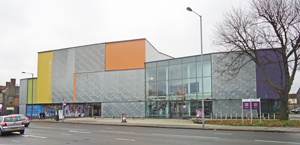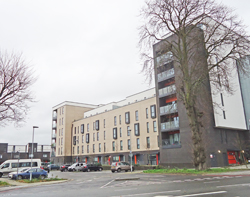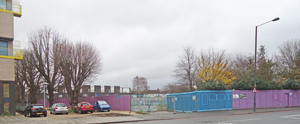Croydon CR0 4RG
Specialist
Mrs Evelyn Burge, wife of the Bishop of Southwark, Chairman of the Federation of Children's Rescue Committees, decided to open a home where children would receive the necessary treatment.
When Coldharbour House in Waddon became available in 1919, the Federation of Committees for the Moral Welfare of Children (previously known as the Federation of Children's Rescue Committees) purchased it by means of a mortgage and a loan. The Federation refused to take the risk of running the Home itself and so a governing body was established.
The Children's Medical Home opened in 1920 - the first of its kind in England. It had 27 beds for the treatment of girls aged between 3 and 14 years who were suffering from gonorrhoea or congenital syphilis. Many were assault cases. Most were referred by the V.D. clinics of the voluntary and L.C.C. hospitals in London, but a few girls were sent from the provinces by their local Medical Officers of Health.
The charge for children from London and the Home Counties was 8s 6d (43p) a week. The Ministry of Health and the LCC provided a substantial grant for maintenance, while parents were asked to pay what they could afford (no child was refused admission or discharged for lack of payment). For children from other areas the weekly charge was 26 shillings (£1.30) for treatment and maintenance, and 5 shillings (25p) for education if the patient was of school age.
Coldharbour House stood in its own grounds of 6 acres, with a garden and a field for the children to play in. There was also a vegetable garden and a small orchard, which enabled the Home to be self-supporting as far as fresh produce was concerned. A gardener, who lived in the cottage by the entrance gate and acted as a lodge-keeper, also looked after the furnaces of the central heating system. There was also an assistant gardener.
The ground floor of the house contained a chapel for the children, a dining room, schoolroom, nursery and washroom, as well as staff rooms, the kitchens and the laundry. On the first floor were the children's dormitories, bathroom and treatment room, as well as accommodation for the nursing staff. The second floor contained bedrooms for the junior maids.
The nursing staff consisted of a Matron, one State-Registered Nurse and an institutionally trained nurse assisted by a nursery maid. The domestic staff comprised a cook and five maids. There were two visiting Medical Officers; a dental surgeon attended every three months.
For most of the patients the duration of disease varied from a few weeks up to two years, although one case had been of seven years duration. On admission, the girl was isolated and rested in bed for two or three days before being allowed to mix with the other children.
In cold weather the girls wore a thick vest, knickers, a warm dress and an overall; in the summer a thin vest, knickers and overall. Sometimes bathing costumes and knickers were worn in very hot weather. If the knickers were of a dark material, a large white patch was sewn inside. Only nightdresses were worn in bed, as pyjamas tended to produce irritation by friction. Pads and diapers were never used for the same reason.
As well as receiving medical care, an LCC Special School had been set up and girls aged from 5 onwards attended lessons under the charge of a qualified teacher. In good weather during the summer, these were held outside. The youngest children, aged from 3 to 5 years, had garden or nursery play, supervised by the children's nurse or nursery maid.
The children got up at 07.30 and breakfasted at 08.00. This was followed by chapel for 10 minutes, then morning school from 09.30 until 12 noon. Lunch was at 12.15, then afternoon school from 14.00 to 16.00. Tea was at 16.30. The meals were simple and contained as much fresh food as possible - milk, butter and fruit. Intervals were filled by playing in the garden or, if the weather was poor, in the covered playground or nursery. After each meal, all china, spoons and forks were washed and then boiled in a special copper.
Each child had a daily bath and went to bed after evening chapel - around 17.30 or 18.00. The older girls were allowed to read in bed, or knit or play with dolls until the curtains were drawn between 19.00 and 19.30. They were encouraged to have a doll or toy animal in bed with them that needed to be held with two hands on the pillow when going to sleep, to discourage masturbation. Toys upstairs were kept on the patient's bed or locker, and not shared with any other child; downstairs toys were communal.
Special precautions were taken to prevent cross-infection of congenital syphilis cases and re-infection of gonococcal cases. Those with an acute infection and profuse purulent discharge were kept in bed until the acute inflammation had subsided and the discharge had lessened. All mattresses were covered with large rubber sheets. No child was allowed on or in another's bed. Bedding and towels were put straight into a copper of 'persil' solution and boiled for at least 30 minutes. Knickers and nightgowns were soaked in weak Lysol before washing and then boiled (except for woollen ones). Vests and overalls were washed with carbolic soap.
Each child was provided with her own flannel and bath towel upstairs, which were kept hanging on the back of her locker. In the washroom downstairs, each child had a face flannel, towel, toothbrush, toothpaste, hairbrush and comb kept in a marked bag hanging on a lettered or numbered peg over the basins.
The Home had no lavatories for the children, who each had their own chamberpots - one kept under their bed upstairs and one kept in a pigeon hole in part of the washroom. Each chamberpot was marked with a letter or a number (sometimes coloured ribbons tied to the handle were used to make the ritual more attractive to the younger patients). The washroom had several separate cubicles where privacy could be obtained and, at the further end, there was a sluice. The children were taught to wash their hands after using the chamberpot.
Temperatures were taken (usually in the axilla, rarely in the mouth and never in the groin or rectum) every morning and treatments were given at intervals during the day, with the children attending in small groups as they were called. Acute cases of vulvo-vaginitis had the first swabbing of the vulva before breakfast. The last treatments of the day were given between 17.30 and 18.30. Various lotions were in use, e.g. protargol 10% in glycerine, mercurochrome 5% or 25% in glycerine, neoreargon in dry powder form. Sitz baths were sometimes given as a preliminary to treatment.
At the end of their treatment, patients remained at the Home for at least two or three months before being referred back to their own hospital for continuation of tests. Sometimes two or three cases remained for 6 months observation until they could be pronounced cured after at least 12 negative tests results (the pathology work for the Home was carried out by the V.D. Laboratory at St Thomas's Hospital).
In 1928 the building was enlarged, after which the Home had 37 beds. In addition, there was an isolation ward with 4 beds.
In 1930 throat and nasal swaps were taken before admission; any carriers of diphtheria were excluded.
During the years 1931 to 1934 the average duration of treatment for 156 cases had been 17 weeks, and the average duration of stay in the Home 30 weeks.
In 1934 the drug Oestroform was given a trial, but the results proved disappointing. Of 9 acute cases, only 3 improved significantly, 4 improved slowly and 2 did not respond to treatment.
The Home closed in 1940 during WW2.
Present status (December 2014)
After the war Coldharbour House became an 'Occupation Centre for Mental Defectives'. It was later demolished and the Waylands Resource Centre for adults with learning difficulties built on its site.
Red Gates Special School and the Waddon Nursery and Infants School, were built in the south part of the grounds.
Waylands closed in 2007 and became a Leisure Centre. Red Gates Special School closed in 2009. In 2010, the Waddon Infants School relocated to the Aerodrome Primary Academy; its site is vacant.
Croydon Council are redeveloping the whole site, which will include 187 new homes.

The Leisure Centre was built on the site of the Home.

New housing occupies the site of Red Gates Special School.

The site is being reveloped (above and below).


The only remaining evidence of Coldharbour House is the street names of Coldharbour Road and Coldharbour Way on the east and south sides of its former grounds.

The Waddon Clinic is tucked behind the Leisure Centre.
How did such young girls acquire a sexually transmitted disease? The causative bacterium Neisseria gonorrhoeae had been discovered in 1879, but belief in the fomite theory of the transmission of the disease persisted surprisingly long into the 20th century.
A fomite is an object or substance which is capable of carrying germs and transferring them from one person to another. Fomites are particularly associated with nosocomial infections, whereby pathogens are carried over by hospital equipment, clothing and bedding.
The emphasis on fomites greatly disregarded the likelihood of sexual transmission in paediatric gonococcal infection. In overcrowded slum conditions, it was believed sharing a bed with a diseased mother could infect a daughter. Unclean hands, sponges, towels and bed linen were all potential fomites.
In fact, from the late 19th century onwards, the toilet seat was frequently held responsible for cross-infection. Many physicians in America believed that toilet seats were too high, so the girl had to slide off, leaving pus behind ready to infect the next girl to use the toilet. (The use of toilet seat covers today reflects the anxiety that infectious diseases can be caught in this way.) The toilet seat was eventually redesigned from an oval to a U-shape, thus reinforcing its role as a fomite.
However, it was well known that gonorrhoea could not survive long outside the body as it has very strict temperature and moisture requirements for growth, and is extremely sensitive to drying. It is, in fact, very difficult to culture. The medical profession largely ignored these facts and, indeed, investigations to test suspected fomites to confirm if they carried the bacteria were rarely performed.
The fomite theory was a convenient way to explain how such very young children had contracted a sexually transmitted disease. Today, of course, any pre-pubertal child with gonorrhoea would be suspected of having been sexually abused, unless proven otherwise.
Evans H 2005 Physician denial and child sexual abuse in America, 1870-2000. In: Krasnick Warsh C, Strong-Boag V (eds) Children's Health Issues in Historical Perspective. Waterloo (Ontario), Wilfred Laurier University Press, 327-353.
Stern AM, Markel H (eds) 2004 Formative Years: Children's Health in the United States, 1880-2000. Ann Arbor, University of Michigan Press.
www.webmed.com
Allen Daley W 1940 Interim Report of the County Medical Officer of Health and School Medical Officer for the Year 1940. London Country Council, 4.
Brown DK 1935 Management of vulvo-vaginitis in children. British Journal of Venereal Disease 11, 207-218.
Bunyon CE 1935 Note on the Children's Medical Home. British Journal of Venereal Disease 11, 218-219.
Hanschell HM 1935 An impression of the Children's Medical Home, Waddon. British Journal of Venereal Disease 11, 219-221.
Return to home page